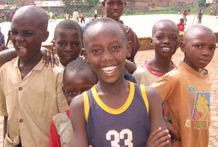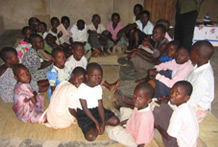Kigali is the capital of Rwanda and is located in the centre of the country. Rwanda is still largely rural, with the majority of its population involved in subsistence agriculture. Kigali has a population of less than one million, approximately one-tenth of Rwanda’s total population. It is estimated that the average household size is five people, and fifty-six percent of Kigali’s population is under the age of twenty.1
Also, because population growth has been incredibly high over the past two decades, especially in the years since the end of the genocide, the government and other social agencies have been unable to keep up with the growth in terms of infrastructure. The city lacks adequate social facilities such as schools and health clinics, water supply, power provision, and sewage and sewerage services; there is not enough housing and so slums have sprung up in many parts of the city. According to MINALOC, “In addition, the urban market status does not support the rural-urban influx and results in a severe unemployment crisis. In search for alternatives, many people are forced into criminal activities.”
Factors in Understanding Development in Rwanda
Any discussion about development in Rwanda, and about development in most of the Developing World, must also include an understanding of the AIDS crisis. Like the genocide, AIDS affects every person in Rwanda. Everyone knows someone who has AIDS or who has died of AIDS; many people have a family member with AIDS. AIDS preys on the most productive members of society, those between fifteen and forty years of age. This strips a country of its teachers, doctors, civil servants, agricultural labourers, etc., and makes the task development incredibly difficult, because people are generally striving for survival and have little time or energy to give to development projects and initiatives.
|
|
Another consequence of both the genocide and the AIDS pandemic is the creation of a new family unit: the child-headed household. A common definition of a child-headed household is “when a child/children take over as the head of their household and fend for themselves without any adults to look after them.”2
Traditionally, when one or both parents die, other members of the extended family and community take responsibility of the orphaned children. However, the genocide claimed over a million Rwandan lives in 1994 and the number of deaths due to AIDS since that time is in the hundreds of thousands. According to ACORD,
The growing number of children left without parents … means that often families can't cope with more children as they don't have enough money, especially if an adult in that household also died from HIV/AIDS, [leaving the family] with less income….Child-headed households are a growing problem because children have no one looking out for them and are therefore vulnerable. They often have to drop out of school to work and have to worry about where their next meal is coming from. Children can be treated badly by others they go to for support because they have no economic or physical power and people might look down on them for being the children of AIDS victims.3
Girls are more at risk because they are seen as more easily taken advantage of. They are forced to exchange sexual favours for food, clothing, and, ironically, hygiene products. Members of the extended family often force child-headed families out of their houses, leaving them homeless and penniless. There is rarely anyone who will stand up for these children who are abused and taken advantage of. ![]()
A recent demographic survey states that five percent of households in Kigali are headed by children. This does not mean to say that five percent of households are orphans; it means that five percent of households are orphans who have not been taken under the care of an aunt, uncle, grandparents, or neighbour. My experience with child-headed households in Kigali was limited to some fieldwork I did for my internship and information I gathered from various NGOs through interviews.
The fieldwork I did involved visiting small, community-based organizations created for people living with HIV/AIDS (or PLWHA). These associations exist so that PLWHA may support and encourage each other and pray and worship in the same church.
Through small weekly or monthly fees, assistance is provided for the dying and bedridden, and the associations often have collective farming and craft-making initiatives to provide food and income to the group. It is usually a pastor or community leader who runs the association; however, most members provide assistance and volunteer their time.
|
|
These associations face great challenges in caring for the many children in their communities. Orphaned very young by HIV/AIDS, children ranging from twelve to twenty-one years of age (some younger or older) find themselves raising their younger siblings. Many drop out of school to support the other children in their homes and struggle to find adequate work. Girls often face more difficulties in this situation; out of desperation, they willingly sacrifice themselves for the benefit of those in their households. They often resort to prostitution for survival. These orphans and vulnerable children often depend upon community organizations for food, school fees, housing needs, and counsel. Sometimes children of deceased association members will retain their parent’s membership and continue going to the group for help. Many find a home with the association; however, the resources and capacity of the associations are not enough to meet all the needs of these children.
Aid for Child-headed Households
Many child-headed households (CHH), however, are denied support by the associations because they have nothing to give to the group in terms of material or financial contributions. Although associations try to sustain as many CHH as they can, many children are ignored because association members fear that if they give counsel or psychological support to these children, they will be solicited for other kinds of support, which they cannot afford, as they already care for their own family as well as other adopted children of deceased family members.4
Because child-headed households have been seen as a burden on a community, the children and youth in these homes are often not included in the processes of making community decisions, program planning and evaluation, and community needs assessments. Although a community might state they need additional support for the growing number of CHH, the CHH themselves are not consulted. ![]()
Recently, some NGOs have started consulting the CHH directly for their input on the programs intended for their benefit. The results of this new approach have proven very effective. Besides having a more precise idea of what these youth need through assessments, one of the goals of involving youth in the planning and implementation of pilot projects is to increase the youths’ self-confidence and ownership of the programs designed to assist them. They are not only beneficiaries of the program, but are encouraged to take part in the planning, implementation, and evaluation of the program.
In a society where children are growing up in an environment of dependence upon outside assistance, this process aims at helping youth in CHH develop a high work ethic, a sense of ownership for their support programs, and an increased sense of autonomy.
Endnotes
1. MINALOC. 2004. “Third Census of Population and Housing of Rwanda—August 2002.” Rwanda National Business Directory: A Project of the Rwanda Investment Promotion Agency. www.rwandagateway.org/article.php3?id_article=1646.
2. 2006. “The Challenges of Women/girl-child Headed Households in Rwanda.” April. http://www.acordinternational.org/index.php/news/The_challenges_of_Women/%20girl-child_headed_households_in_Rwanda.
3. Ibid.
4. Also linked to the increase in child-headed households (CHH) is the loss of means to pass on Rwandan customs and traditions from parents to children. The rural-to-urban migration has brought younger and younger people into the city. They come seeking work and survival and become isolated from their kinship group, family, and home community.



